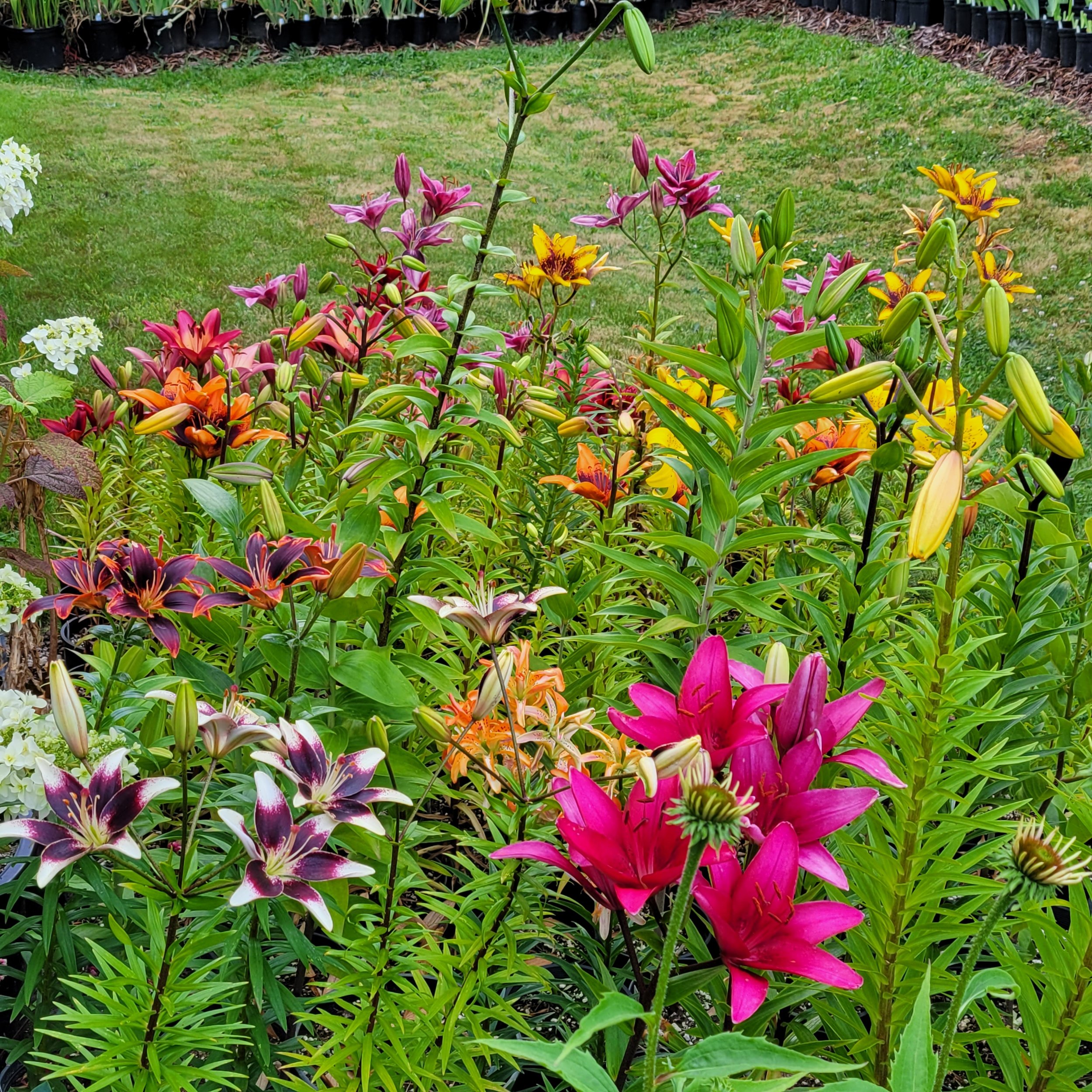
Lilium (True Lilies)
Unlike their similarly named counterparts elsewhere on this site, true lilies grow from true bulbs (as opposed to corms, tubers, rhizomes, etc.). The bulb can be anywhere from the size of a large marble up to nearly that of a baseball in some of the hybrid types. The bulbs are scaly, meaning that the outer layers can break off, since they only attach at the bulb’s base, where the true roots attach (think of the bulb as looking kind of like a flower, with the petals of the flower being the scales…outer petals are easier to remove because of their location).
As with Iris, lilies have several different classes, based largely on overall plant size, flower structure/size/orientation on the plant, and somewhat less on bloom time. The classes I grow currently are the Asiatic, Oriental, Tiger, and Orienpet classes. All do best in full sun (six hours or more daily), well drained soil (fleshy root structures rot in excess moisture), and usually don’t require a whole lot in the way of supplemental nutrition…though bone meal supplied for calcium (provided you don’t have dogs that have access) helps the bulbs develop normally. Bloom time is roughly around June through July, right between Iris and Hemerocallis seasons, bridging any gaps in the timing. Don’t be alarmed if they yellow out and die back a month or two after blooming wraps, especially if they didn’t produce any seed pods. It’s normal, and it varies from year to year. As soon as the bulbs have recharged for the next year, they no longer need the green parts, and the plant goes dormant, regardless of the weather.
Asiatics are by far the most commonly encountered, and usually are the proverbial early birds. They’re typified by small to medium-statured plants carrying between 6 and 15 buds at the very top. Each bulb usually sends up one stem, and each bulb normally produces new offsets annually. Flowers more often than not are oriented upward, can occur in colors ranging from white to pinks, yellows, reds, and purples, with or without “freckles” or darker zones toward the center, and the prominent anthers carry pollen that can stain fabrics that come in contact with it. I have yet to encounter an Asiatic variety that has had a scent.
Orientals are normally medium to tall statured plants, still with one stem per bulb in the majority of cases. They bloom after the Asiatics pass their peak. Leaves are broader and often longer than those of their smaller counterparts. Flowers are much larger and usually number between 6 and 12 per plant. They’re normally oriented outward and slightly downward, and occur in whites, pinks, reds, and varying combinations with or without freckles. The ever-popular Stargazer belongs in this class. Orientals nearly always have a robust scent…and those anthers also have that staining pollen.
The tigers (tigrinum) take their time in getting going, coloring up around the time the Orientals do. Caught about midway between the Asiatics and the Orientals in height, the flowers appear a little daintier than the Asiatics and are oriented downward and slightly outward. Colors are more or less solids in whites, reds, oranges, and yellows with copious freckles. Petals are strongly reflexed, that is, they curve backward toward the stem and away from the stamens and stigma. Flowers carry no scent.
Last, the Orienpets are hybrids of Oriental and Trumpet lilies. At this time, I only grow one such variety. These can be truly massive plants (and bulbs!)…reaching heights of six feet or more. The bulb of the oldest specimen I have is nearly the size of a softball and is growing in a three gallon pot. Flower orientation is similar to that of the Orientals, out and down. Colors can be all over the map, but primarily warmer colors. The highest bud count I’ve had so far is about 8. I suspect that growing in the ground will likely increase that. Both Trumpet and Oriental lilies carry a scent, so it likely comes as no surprise that their hybrids do, as well. These bloom slightly ahead of or with the Orientals.
If you plan to do some shifting in beds that have lilies in them, be sure to mark their locations before you start, especially if they start going dormant before you’re ready to start digging. I can’t count how many sleeping bulbs I’ve sliced through while digging because I’d forgotten where the lilies were.
I will be offering lily bulbs in about March to April, depending on the weather, and limited sales again after dormancy starts around August-September. They’ll be shipped like everything else, via USPS Priority Mail, after being allowed to dry a little, and then bagged with a sprinkling of the potting mix they normally grow in.
To view what I expect to have available, please venture over to the Shop page. I recently discontinued a handful of varieties and have since brought in new ones. They’re under evaluation currently, with release expected in 2024. Right now, I’m observing them to see if they are as labeled while building up their numbers.
Please see the Shop page for varieties available. Orders are being taken now. Early birds get the proverbial worm, as quantities are generally low and sell out quickly. Shipping of lilies and Hostas will begin in early March and run through Tax Day, or when stock is exhausted, whichever comes first.
Thanks for reading!
